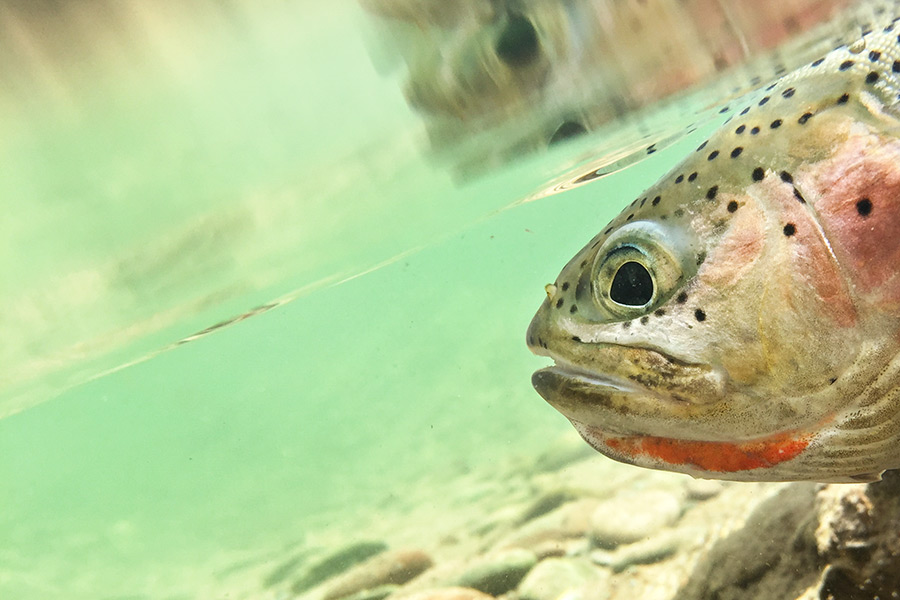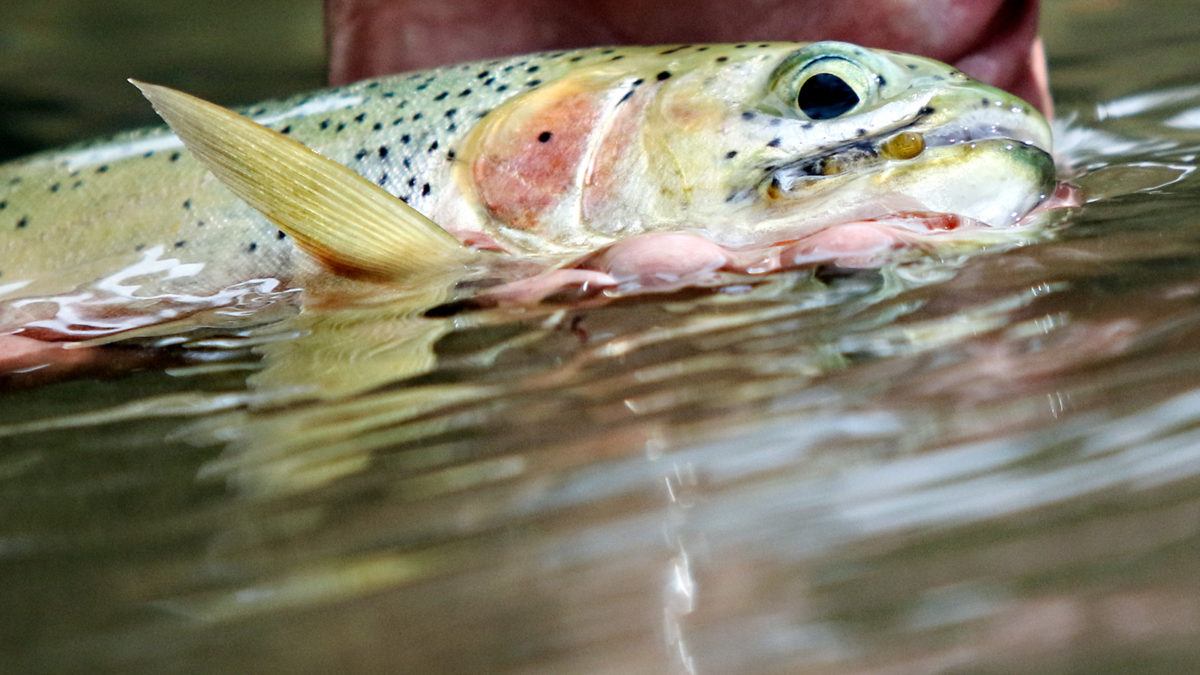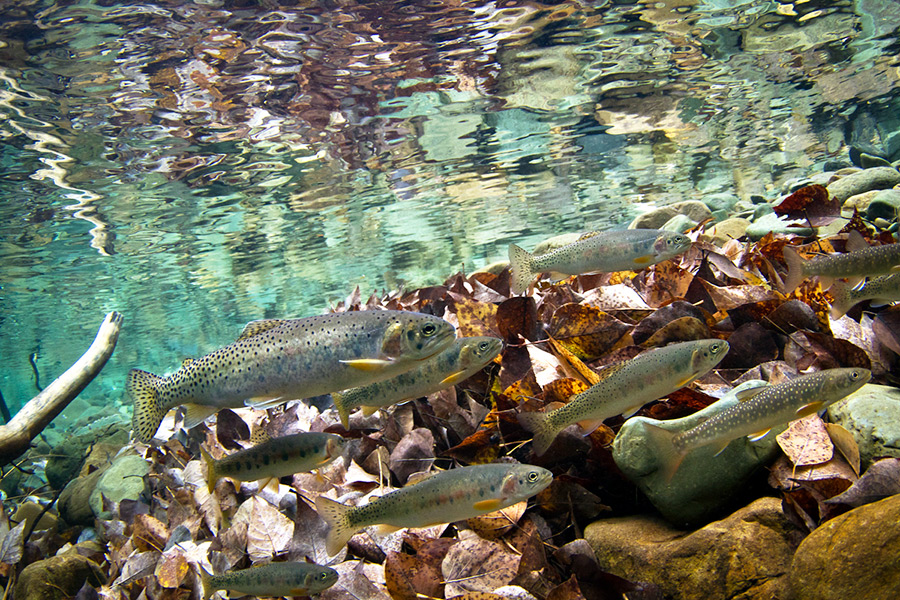Climate Change, Aquatic Invaders Turn Up the Heat on Native Trout
Using three decades of monitoring data, local researchers reveal how the interplay of aquatic invaders and warming stream temperatures are driving steep declines in native trout populations
By Tristan Scott
As a stronghold for native trout species, as well as a mountainous region that has warmed at nearly twice the rate of the global average over the last century, the northern Rocky Mountains of Montana are an ideal laboratory setting for climate analysis.
Stream temperatures are rising, summer flows are decreasing and wintertime flooding is more prevalent, a trifecta of climate-induced environmental factors that don’t bode well for the future of Montana’s native, cold-water dependent fish species — westslope cutthroat and bull trout. Until recently, however, researchers cataloging the direct challenges to native fish posed by shifting climatic conditions hadn’t considered that those well-established stressors might actually benefit the distribution of invasive fish such as rainbow and brook trout, which could further imperil natives by promoting hybridization.
Now, as researchers model future climate scenarios to better understand what’s driving the decline of Montana’s prized native trout, they’re learning that, even though bull and westslope cutthroat trout are ecologically similar, and even though both are expected to decline as global climate change persists, their divergent responses to the planet’s warming trends reveal the need for unique species-specific conservation strategies.
“Both native trout species are likely to decline under future climate scenarios, but the reasons for the declines are different,” explained Donovan Bell, an evolutionary ecologist studying the impact of human-caused stressors on native species. “For westslope cutthroat trout, the decline appears to be due to negative interactions with invasive species, namely rainbow and brook trout due to hybridization.”
For bull trout, however, the climate-induced stressors are more direct; the cold-water reliant species is extremely sensitive to the perils of rising water temperatures and reduced summertime stream flows, but they don’t appear to be as bothered by the nonnative fish species radiating through the region’s river systems (the study did not assess the interaction of invasive species and bull trout in lake habitats, where their distribution has plummeted as a result of introduced populations of lake trout). Remarkably, westslope cutthroat — a species so emblematic in Montana it’s been adopted as the state fish — appear to possess key genetic adaptations allowing them to withstand warmer water temperatures, only to be crowded out by surging populations of nonnatives like rainbow trout, brown trout and brook trout, which were widely introduced for sportfishing during the late 1800s through the early 1970s.
“We did a sensitivity analysis where we essentially removed nonnative species from the landscape to see what westslope cutthroat trout would do and they appear to be very robust in the absence of invasive species,” Bell said, noting that their fine-tuned genetic programming has allowed the fish to adapt to changing climatic conditions over the course of milennia. “The finding does seem to have pretty clear implications for conservation and management actions.”
That means the suppression of invasive trout species may be the most effective conservation strategy to protect westslope cutthroat trout, while a management strategy centered on maintaining and improving cold and connected aquatic habitat works better for bull trout.

As the lead author of a new study published in the peer-reviewed journal Science Advances, Bell teamed up with researchers from the University of Montana (UM), U.S. Geological Survey (USGS) and Montana Fish, Wildlife and Parks (FWP) to answer three main questions: How have the distributions of native and invasive trout shifted in Montana over the last 30 years? How will they change in the future? And what factors are causing those changes?
Using 21,917 surveys collected by FWP biologists over the last 30 years, Bell, a Ph.D candidate at UM, worked in concert with some of the top ecologists in the region to quantify the impacts of climate change on the past and future distributions of five interacting native and invasive trout species throughout the northern Rocky Mountains — native westslope cutthroat trout and bull trout, as well as invasive brook trout, brown trout and rainbow trout.
The researchers found native bull trout and westslope cutthroat trout occupancy (defined as the amount of stream where a species is present) declined by 18% and 6%, respectively, between 1993 and 2018 and are predicted to decrease by an additional 39% and 16% by 2080. Although invasive brook trout populations also were expected to decline, invasive brown and rainbow trout have expanded their range due to rising water temperatures and appear poised to prosper under future climate change.
“Other studies that looked at broad-scale climate-induced trends in trout suggest warming water temperatures would cause a decline in distribution for all trout species,” Donovan said. “In the northern Rockies, at least, that doesn’t appear to be the case. At least for brown trout and rainbow trout, they are likely to actually benefit from climate change while the native trout populations decline.”
Unless, that is, appropriate conservation action is taken.
“Our results suggest that tailoring conservation strategies to specific species and specific climate-change threats is important for native fish conservation,” Bell said.

The study is the first of its kind to reveal how climate change can impact ecologically similar native trout species in different ways. And although it paints a grim picture for the future health of native fish populations, it could also help sharpen management tools to facilitate conservation.
“Globally, climate-induced changes to aquatic habitats are predicted to threaten at least one-third of freshwater fishes, and some invasive species could take advantage of such changes,” said Clint Muhlfeld, a USGS scientist and co-author of the study. “These scenarios seem to be playing out in our backyard with native and invasive trout.”
The study also highlights the importance of using and maintaining long-term datasets covering large regions to shed light on the complex ways climate and invasive species work in concert to affect native species.
“It’s exciting to have the opportunity to use data meticulously collected over decades in Montana to convincingly answer complex questions like these,” said David Schmetterling, fisheries research coordinator for Montana FWP, who explained that the data on which the study is premised represents only a portion of what the agency has compiled in the past half-century.
“It’s a pretty amazing dataset that spans decades and includes all of the fish population surveys that have ever been conducted by fish and wildlife biologists across the state,” Schmetterling continued. “This was an amazing opportunity to examine how climate change and invasive species interact to influence the distribution of native fish throughout the region. It is in my opinion the most comprehensive analysis of climate change on native trout that’s been done.”
Andrew Whiteley, a study co-author and UM associate professor, said Montana already has lost populations of cold-adapted native fish species and likely will continue to as climate change progresses over this century.
“This is particularly troubling in a state where cold-water fisheries now contribute nearly $650 million a year to our economy,” said Whiteley, who studies fisheries and conservation genetics. “But all is not lost for these economically, ecologically and culturally important species as long as appropriate conservation action is taken.”
UM study co-authors include Bell, Paul Lukacs and Whiteley from the W.A. Franke College of Forestry and Conservation and Diane Whited from the Flathead Lake Biological Station. USGS co-authors include Muhlfeld, Timothy Cline and Robert Al-Chokhachy. Montana FWP authors include Ryan Kovach and Schmetterling.